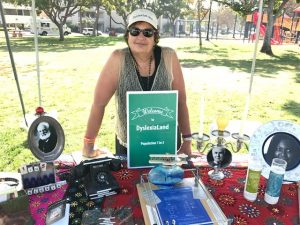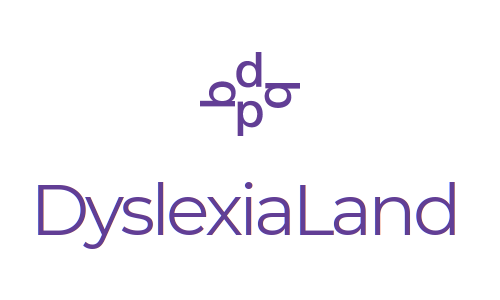Dyslexia-themed art? At times, words are just too much, verbal, and especially when dealing with dyslexia, written. That’s one reason why I started making dyslexia-themed assemblage art.
In my advocacy work meeting with students in classrooms to provide them a greater understanding of dyslexia, I learned right away that I had to do more than just talk and talk and talk! For my classroom presentations, I created a “BDPQ Exhibit” of these four letters that are actually identical symbols (bdpq). After that, I began thinking about how to create visual items that would convey information—and even better, emotion—about dyslexia without using too many words.

An open-air exhibit of dyslexia-themed assemblage art by Cheri Rae.
In attempting to offer an an alternative definition of dyslexia and some altogether different ways of regarding dyslexia, my art takes on three themes:
–depictions of famous accomplished individuals with dyslexia
–depictions of dyslexia dilemmas
–depictions of classroom experience, and in particular, special education
For me, coming up with the ideas, planning them out, and producing the art is a creatively satisfying activity that provides a balance to the stress and responsibility of advocacy and planning events.
For my first show, I wrote an Artist Statement that I hope still rings true.
Artist Statement: Welcome to DyslexiaLand (Population 1 in 5)
For the past several years, I have learned everything I possibly could about dyslexia in order to support my son in his struggles in school with reading, writing and spelling. He is one of the 1 in 5 who have dyslexia, a well-researched learning difference that nevertheless, is very confusing to many students, parents, educators, and the public at large.
There’s a flip side to dyslexia, one of great accomplishment and creativity, as evidenced by the astonishing numbers of entrepreneurs and entertainers, inventors and innovators, artists and achievers in countless categories—who have dyslexia.
Perhaps they are successful in spite of their dyslexia—gaining wisdom, persistence and determination from the struggle. Perhaps they are successful because of their dyslexia—and a uniquely right-brained way of looking at the world.
“DyslexiaLand” is what I call it: a place of darkness and light, obstacles and opportunities that can be navigated successfully through awareness and understanding. It becomes a matter of choice.
With that in mind, the pieces in this collection were created to help visualize characteristics and issues of dyslexia and individuals who have/had it. They were assembled from discarded materials, many of them found right here at Art from Scrap. Since individuals with dyslexia are highly visual and 3-D thinkers, it was important to honor them by de-emphasizing the written word while still communicating essential information.
In many ways, students with dyslexia are often devalued in school, where their weaknesses are incessantly exposed. They must rediscover their true value in the real world where their strengths redefine their individual worth far beyond the classroom. It seems appropriate to reassemble scrap into thoughtful pieces that celebrate individuals with dyslexia, and increase awareness about this most common learning difference.


